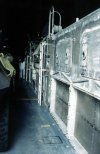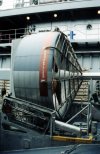 |
This shot looks toward the forward end of an LCAC (probably on PENSACOLA);
the two nozzles toward the bow are used to help steer the LCAC, and they
are fed waste air that is bled from under the LCAC's cushion. An LCAC has
four gas turbine engines (essentially jet engines), two of which turn the
drive propellors and two which force air under the LCAC to lift it from
the ground or water. |
 |
Looking down into the welldeck of an LSD, and the LCAC within. An LCAC
can travel over land or water with ease, and at great speed. |
 |
Here, the ramps of two LCACs overlap each other; the WHIDBEY
ISLAND class of LSD can carry up to four LCACs at one time. The two
propellors seen here are variable pitch, and are each driven by a gas turbine
engine. The tail end of two LAV 25 armoured personnel carriers can be seen
to the bottom right. The control cockpit on the after LCAC can be seen
to the left of the photo behind a prop. |
 |
This picture looks forward along the starboard side of an LCAC on GUNSTON
HALL. The construction of these craft depends heavily on aluminum, as can
be seen from the engine housing to the right. |
 |
A close-up of the port propellor. |
 |
Taken from the deck of an LCAC looking aft along the well deck on GUNSTON
HALL. |


